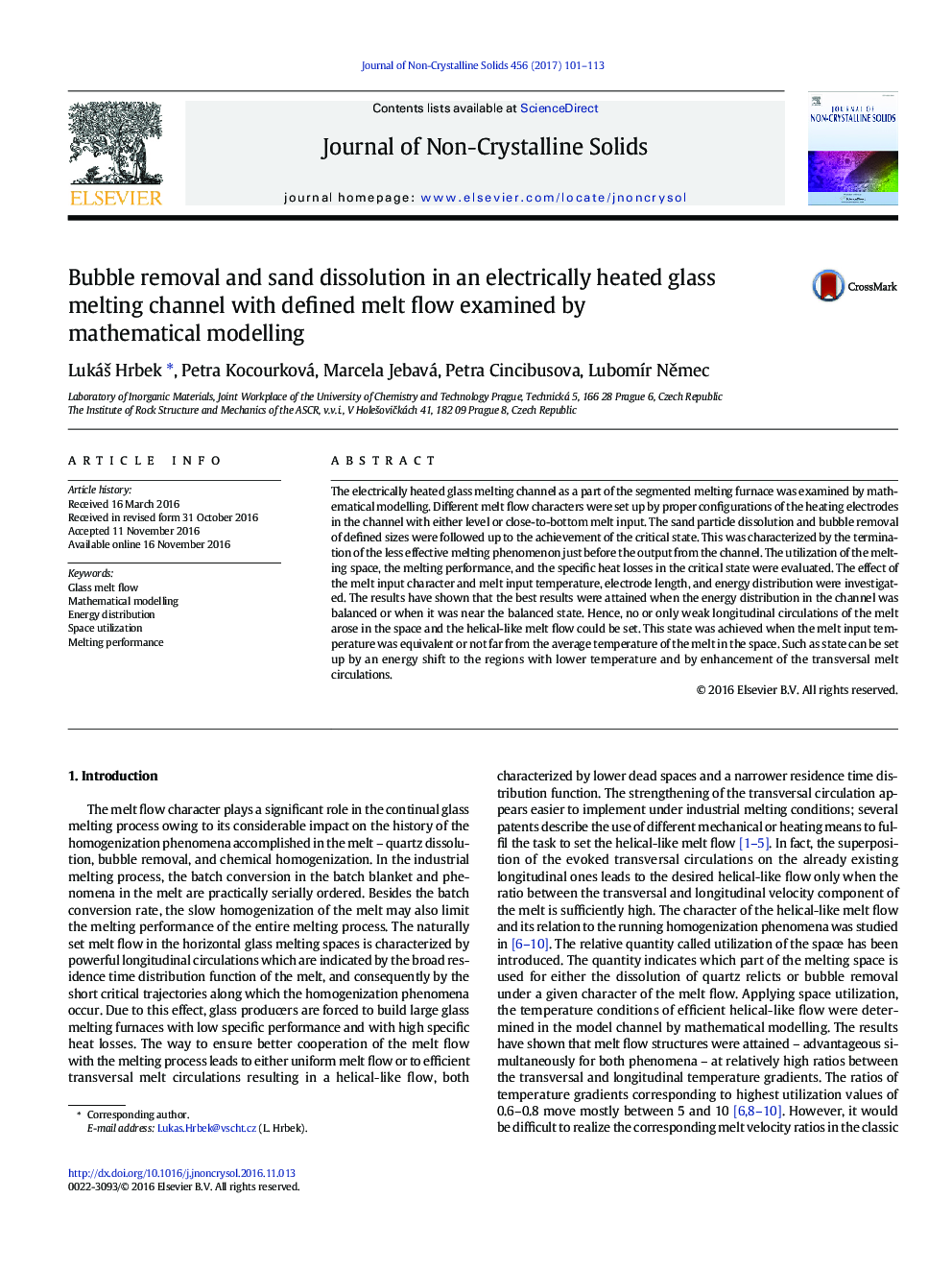| کد مقاله | کد نشریه | سال انتشار | مقاله انگلیسی | نسخه تمام متن |
|---|---|---|---|---|
| 5441388 | 1510390 | 2017 | 13 صفحه PDF | دانلود رایگان |
عنوان انگلیسی مقاله ISI
Bubble removal and sand dissolution in an electrically heated glass melting channel with defined melt flow examined by mathematical modelling
ترجمه فارسی عنوان
حذف حباب و انحلال شن در یک کانال ذوب شیشه ای الکتریکی با جریان ذوب تعریف شده توسط مدل سازی ریاضی
دانلود مقاله + سفارش ترجمه
دانلود مقاله ISI انگلیسی
رایگان برای ایرانیان
کلمات کلیدی
ذوب شیشه ای مدل سازی ریاضی، توزیع انرژی، استفاده از فضا، عملکرد ذوب،
ترجمه چکیده
کانال ذوب شیشه ای گرم به عنوان بخشی از کوره ذوب بخشش با استفاده از مدل سازی ریاضی مورد بررسی قرار گرفت. کاراکترهای جریان ذوب متفاوت توسط تنظیمات مناسب الکترودهای گرمایش در کانال با هر سطح یا ورودی ذوب به انتهای آن تنظیم شده است. انحلال ذرات شن و حذف حباب اندازه های تعریف شده تا رسیدن به حالت بحرانی مورد بررسی قرار گرفت. این امر با پایان دادن به پدیده ذوب پایین مؤثر درست قبل از خروجی از کانال مشخص شد. استفاده از فضای ذوب، عملکرد ذوب و تلفات حرارت خاص در حالت بحرانی مورد ارزیابی قرار گرفت. اثر کاراکتر ورودی ذوب و دما ورودی ذوب، طول الکترود و توزیع انرژی مورد بررسی قرار گرفت. نتایج نشان می دهد که بهترین نتایج در زمانی که توزیع انرژی در کانال متعادل شده بود یا زمانی که نزدیک به حالت متعادل بود، بدست آمد. از این رو، هیچ و یا تنها ضخامت طولی جریان انباشته ذوب در فضا بوجود آمد و جریان جریان ذوب اسپیلئولی را می توان تنظیم کرد. این وضعیت زمانی حاصل شد که دمای ورودی ذوب معادل آن یا به دور از دمای متوسط ذوب در فضا نبود. مانند حالت را می توان با تغییر انرژی به مناطق با درجه حرارت پایین تر و با افزایش توزیع های ذوب ترانزیت تنظیم کرد.
موضوعات مرتبط
مهندسی و علوم پایه
مهندسی مواد
سرامیک و کامپوزیت
چکیده انگلیسی
The electrically heated glass melting channel as a part of the segmented melting furnace was examined by mathematical modelling. Different melt flow characters were set up by proper configurations of the heating electrodes in the channel with either level or close-to-bottom melt input. The sand particle dissolution and bubble removal of defined sizes were followed up to the achievement of the critical state. This was characterized by the termination of the less effective melting phenomenon just before the output from the channel. The utilization of the melting space, the melting performance, and the specific heat losses in the critical state were evaluated. The effect of the melt input character and melt input temperature, electrode length, and energy distribution were investigated. The results have shown that the best results were attained when the energy distribution in the channel was balanced or when it was near the balanced state. Hence, no or only weak longitudinal circulations of the melt arose in the space and the helical-like melt flow could be set. This state was achieved when the melt input temperature was equivalent or not far from the average temperature of the melt in the space. Such as state can be set up by an energy shift to the regions with lower temperature and by enhancement of the transversal melt circulations.
ناشر
Database: Elsevier - ScienceDirect (ساینس دایرکت)
Journal: Journal of Non-Crystalline Solids - Volume 456, 15 January 2017, Pages 101-113
Journal: Journal of Non-Crystalline Solids - Volume 456, 15 January 2017, Pages 101-113
نویسندگان
LukáÅ¡ Hrbek, Petra Kocourková, Marcela Jebavá, Petra Cincibusova, LubomÃr NÄmec,
